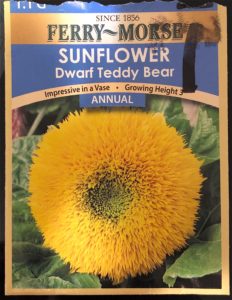Planting Sunflowers
go.ncsu.edu/readext?813516
en Español / em Português
El inglés es el idioma de control de esta página. En la medida en que haya algún conflicto entre la traducción al inglés y la traducción, el inglés prevalece.
Al hacer clic en el enlace de traducción se activa un servicio de traducción gratuito para convertir la página al español. Al igual que con cualquier traducción por Internet, la conversión no es sensible al contexto y puede que no traduzca el texto en su significado original. NC State Extension no garantiza la exactitud del texto traducido. Por favor, tenga en cuenta que algunas aplicaciones y/o servicios pueden no funcionar como se espera cuando se traducen.
Português
Inglês é o idioma de controle desta página. Na medida que haja algum conflito entre o texto original em Inglês e a tradução, o Inglês prevalece.
Ao clicar no link de tradução, um serviço gratuito de tradução será ativado para converter a página para o Português. Como em qualquer tradução pela internet, a conversão não é sensivel ao contexto e pode não ocorrer a tradução para o significado orginal. O serviço de Extensão da Carolina do Norte (NC State Extension) não garante a exatidão do texto traduzido. Por favor, observe que algumas funções ou serviços podem não funcionar como esperado após a tradução.
English
English is the controlling language of this page. To the extent there is any conflict between the English text and the translation, English controls.
Clicking on the translation link activates a free translation service to convert the page to Spanish. As with any Internet translation, the conversion is not context-sensitive and may not translate the text to its original meaning. NC State Extension does not guarantee the accuracy of the translated text. Please note that some applications and/or services may not function as expected when translated.
Collapse ▲This page provides ideas based around planting sunflowers.
We chose three types of sunflowers to plant: Dwarf Teddy Bear, Jua Maya Hybrid, and Mammoth. We chose these three because they would give us varying heights where we planned to plant them.
We prepared our seed starter trays on March 24, 2020. Here are pictures of our seed trays.

Dwarf Teddy Bear Seed Pack – Front

Jua Maya Hybrid Seed Pack – Front

Mammoth Seed Pack – Front

Seedlings on March 29, 2020

Single seedling on March 29, 2020

Trays of seedlings on March 30, 2020

One tray of seedlings on March 30, 2020

Tray of seedlings on April 1, 2020

Dwarf Teddy Bear Sunflower Seedlings on April 5, 2020

Mammoth Sunflower Seedlings on April 5, 2020

Seed trays with seedlings on April 5, 2020
Activities
Planting seeds with kids is a great opportunity to learn many life lessons. After preparing the trays and planting the seeds, there is still much work to do and many lessons to be learned. Children learn the importance of taking care of their seedlings while watching them grow. Imagine a child’s excitement when a small seedling starts to emerge from the soil that they so carefully tucked it under just days before!
As those seedlings continue to grow, the child continues to nurture and care for the small, fragile plants that they now have.
In addition to preparing seed trays, planting seeds, and caring for the young seedling until they are ready for transplanting, you may find that you have additional time for related activities. Below you will find a few activities centered around planting seeds.
- Have kids count and record the number of seeds they have in each pack. Additionally, you can measure the seeds if they are large enough to be handled by small hands. You can download this simple record sheet for counting and measuring. You can also use this completed Sunflower record sheet as a reference. Be creative in counting! For example, younger children may need to practice counting by 2’s, 5’s, or 10’s. We counted by 5’s in this video.
- On the back of the seed packets, you should find information about germination time and mature height. Before showing this to kids, have them write a hypothesis on which one will germinate the quickest or which one will grow the tallest based on the size of the seeds.
- Compare the days to germinate, mature plant height, or days to bloom found on the backs of the seed packets. In this example, we compared mature plant height, using this worksheet. Download a blank worksheet that you can fill in for what you are comparing.

Back of Seed Packets
- Download My Plant’s Weekly Growth Worksheet to record weekly measurements of your seedlings.
- Turn it into an art project! We used yellow construction paper, cut into 1-inch strips. We then glued the ends together. We cut a stem and a leaf from green paper and a black circle for the center. A fun variation would be to use sunflower seeds in the center for an added touch.

Gluing strips of paper for a sunflower craft

Gluing strips of paper together

Completed Sunflower Art Project
- For younger children who may be working on word families, this is a fun option. We cut yellow petals from construction paper and glued them to a circle cut from card stock paper. We then colored a paper plate yellow and glued a large black circle in the center. On the petals we wrote the word families and on the plate we wrote the alphabet. We secured the word family sunflower with a small fastener.

Word Family Sunflower
- Complete the Parts of the Plant Worksheet.
- Match the function with the part with this Plant Function Matching Worksheet.
Be creative and don’t limit the opportunity for learning. Have fun!




